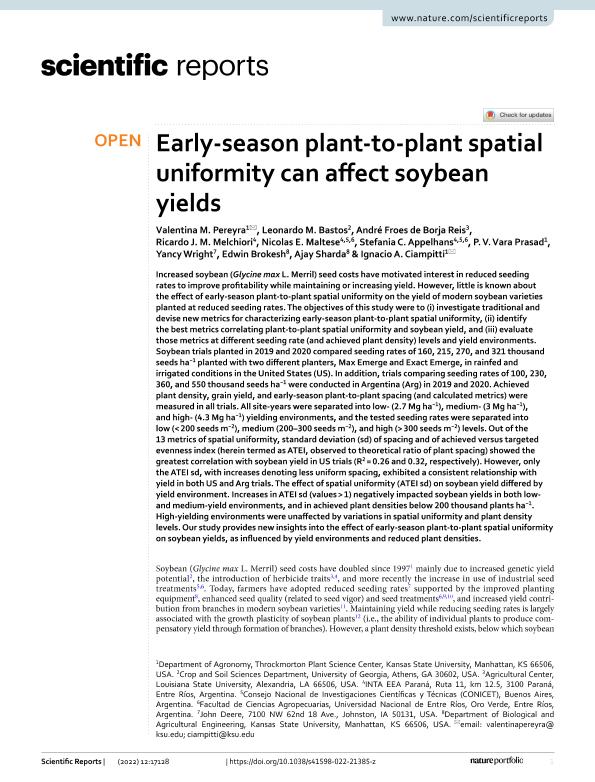Artículo
Early-season plant-to-plant spatial uniformity can affect soybean yields
Pereyra, Valentina M.; Bastos, Leonardo M.; Froes de Borja Reis, André; Melchiori, Ricardo J. M.; Maltese, Nicolás Elías ; Appelhans, Stefania Carolina
; Appelhans, Stefania Carolina ; Vara Prasad, P. V.; Wright, Yancy; Brokesh, Edwin; Sharda, Ajay; Ciampitti, Ignacio Antonio
; Vara Prasad, P. V.; Wright, Yancy; Brokesh, Edwin; Sharda, Ajay; Ciampitti, Ignacio Antonio
 ; Appelhans, Stefania Carolina
; Appelhans, Stefania Carolina ; Vara Prasad, P. V.; Wright, Yancy; Brokesh, Edwin; Sharda, Ajay; Ciampitti, Ignacio Antonio
; Vara Prasad, P. V.; Wright, Yancy; Brokesh, Edwin; Sharda, Ajay; Ciampitti, Ignacio Antonio
Fecha de publicación:
10/2022
Editorial:
Nature
Revista:
Scientific Reports
ISSN:
2045-2322
Idioma:
Inglés
Tipo de recurso:
Artículo publicado
Clasificación temática:
Resumen
Increased soybean (Glycine max L. Merril) seed costs have motivated interest in reduced seeding rates to improve profitability while maintaining or increasing yield. However, little is known about the effect of early-season plant-to-plant spatial uniformity on the yield of modern soybean varieties planted at reduced seeding rates. The objectives of this study were to (i) investigate traditional and devise new metrics for characterizing early-season plant-to-plant spatial uniformity, (ii) identify the best metrics correlating plant-to-plant spatial uniformity and soybean yield, and (iii) evaluate those metrics at different seeding rate (and achieved plant density) levels and yield environments. Soybean trials planted in 2019 and 2020 compared seeding rates of 160, 215, 270, and 321 thousand seeds ha−1 planted with two different planters, Max Emerge and Exact Emerge, in rainfed and irrigated conditions in the United States (US). In addition, trials comparing seeding rates of 100, 230, 360, and 550 thousand seeds ha−1 were conducted in Argentina (Arg) in 2019 and 2020. Achieved plant density, grain yield, and early-season plant-to-plant spacing (and calculated metrics) were measured in all trials. All site-years were separated into low- (2.7 Mg ha−1), medium- (3 Mg ha−1), and high- (4.3 Mg ha−1) yielding environments, and the tested seeding rates were separated into low (< 200 seeds m−2), medium (200–300 seeds m−2), and high (> 300 seeds m−2) levels. Out of the 13 metrics of spatial uniformity, standard deviation (sd) of spacing and of achieved versus targeted evenness index (herein termed as ATEI, observed to theoretical ratio of plant spacing) showed the greatest correlation with soybean yield in US trials (R2 = 0.26 and 0.32, respectively). However, only the ATEI sd, with increases denoting less uniform spacing, exhibited a consistent relationship with yield in both US and Arg trials. The effect of spatial uniformity (ATEI sd) on soybean yield differed by yield environment. Increases in ATEI sd (values > 1) negatively impacted soybean yields in both low- and medium-yield environments, and in achieved plant densities below 200 thousand plants ha−1. High-yielding environments were unaffected by variations in spatial uniformity and plant density levels. Our study provides new insights into the effect of early-season plant-to-plant spatial uniformity on soybean yields, as influenced by yield environments and reduced plant densities.
Palabras clave:
GLYCINE MAX
,
SEEDING RATE
,
UNIFORMITY
,
YIELD ENVIRONMENTS
Archivos asociados
Licencia
Identificadores
Colecciones
Articulos(SEDE CENTRAL)
Articulos de SEDE CENTRAL
Articulos de SEDE CENTRAL
Citación
Pereyra, Valentina M.; Bastos, Leonardo M.; Froes de Borja Reis, André; Melchiori, Ricardo J. M.; Maltese, Nicolás Elías; et al.; Early-season plant-to-plant spatial uniformity can affect soybean yields; Nature; Scientific Reports; 12; 1; 10-2022; 1-10
Compartir
Altmétricas



